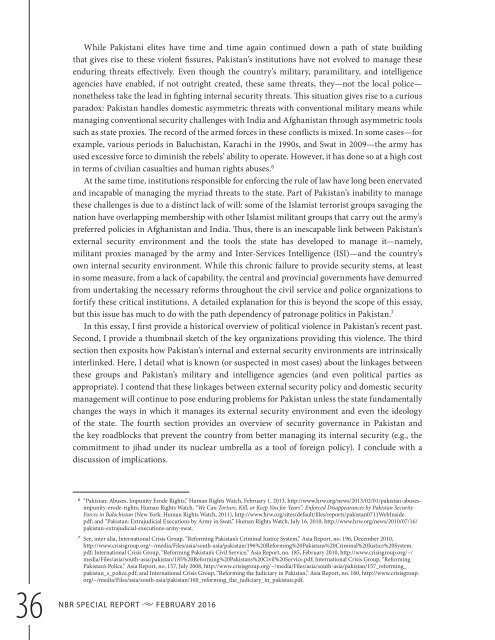pakistan’s
SR55_Mapping_Pakistan_February2016
SR55_Mapping_Pakistan_February2016
You also want an ePaper? Increase the reach of your titles
YUMPU automatically turns print PDFs into web optimized ePapers that Google loves.
While Pakistani elites have time and time again continued down a path of state building<br />
that gives rise to these violent fissures, Pakistan’s institutions have not evolved to manage these<br />
enduring threats effectively. Even though the country’s military, paramilitary, and intelligence<br />
agencies have enabled, if not outright created, these same threats, they—not the local police—<br />
nonetheless take the lead in fighting internal security threats. This situation gives rise to a curious<br />
paradox: Pakistan handles domestic asymmetric threats with conventional military means while<br />
managing conventional security challenges with India and Afghanistan through asymmetric tools<br />
such as state proxies. The record of the armed forces in these conflicts is mixed. In some cases—for<br />
example, various periods in Baluchistan, Karachi in the 1990s, and Swat in 2009—the army has<br />
used excessive force to diminish the rebels’ ability to operate. However, it has done so at a high cost<br />
in terms of civilian casualties and human rights abuses. 6<br />
At the same time, institutions responsible for enforcing the rule of law have long been enervated<br />
and incapable of managing the myriad threats to the state. Part of Pakistan’s inability to manage<br />
these challenges is due to a distinct lack of will: some of the Islamist terrorist groups savaging the<br />
nation have overlapping membership with other Islamist militant groups that carry out the army’s<br />
preferred policies in Afghanistan and India. Thus, there is an inescapable link between Pakistan’s<br />
external security environment and the tools the state has developed to manage it—namely,<br />
militant proxies managed by the army and Inter-Services Intelligence (ISI)—and the country’s<br />
own internal security environment. While this chronic failure to provide security stems, at least<br />
in some measure, from a lack of capability, the central and provincial governments have demurred<br />
from undertaking the necessary reforms throughout the civil service and police organizations to<br />
fortify these critical institutions. A detailed explanation for this is beyond the scope of this essay,<br />
but this issue has much to do with the path dependency of patronage politics in Pakistan. 7<br />
In this essay, I first provide a historical overview of political violence in Pakistan’s recent past.<br />
Second, I provide a thumbnail sketch of the key organizations providing this violence. The third<br />
section then exposits how Pakistan’s internal and external security environments are intrinsically<br />
interlinked. Here, I detail what is known (or suspected in most cases) about the linkages between<br />
these groups and Pakistan’s military and intelligence agencies (and even political parties as<br />
appropriate). I contend that these linkages between external security policy and domestic security<br />
management will continue to pose enduring problems for Pakistan unless the state fundamentally<br />
changes the ways in which it manages its external security environment and even the ideology<br />
of the state. The fourth section provides an overview of security governance in Pakistan and<br />
the key roadblocks that prevent the country from better managing its internal security (e.g., the<br />
commitment to jihad under its nuclear umbrella as a tool of foreign policy). I conclude with a<br />
discussion of implications.<br />
36<br />
NBR<br />
6 “Pakistan: Abuses, Impunity Erode Rights,” Human Rights Watch, February 1, 2013, http://www.hrw.org/news/2013/02/01/pakistan-abusesimpunity-erode-rights;<br />
Human Rights Watch, “We Can Torture, Kill, or Keep You for Years”: Enforced Disappearances by Pakistan Security<br />
Forces in Balochistan (New York: Human Rights Watch, 2011), http://www.hrw.org/sites/default/files/reports/pakistan0711WebInside.<br />
pdf; and “Pakistan: Extrajudicial Executions by Army in Swat,” Human Rights Watch, July 16, 2010, http://www.hrw.org/news/2010/07/16/<br />
pakistan-extrajudicial-executions-army-swat.<br />
7 See, inter alia, International Crisis Group, “Reforming Pakistan’s Criminal Justice System,” Asia Report, no. 196, December 2010,<br />
http://www.crisisgroup.org/~/media/Files/asia/south-asia/pakistan/196%20Reforming%20Pakistans%20Criminal%20Justice%20System.<br />
pdf; International Crisis Group, “Reforming Pakistan’s Civil Service,” Asia Report, no. 185, February 2010, http://www.crisisgroup.org/~/<br />
media/Files/asia/south-asia/pakistan/185%20Reforming%20Pakistans%20Civil%20Service.pdf; International Crisis Group, “Reforming<br />
Pakistan’s Police,” Asia Report, no. 157, July 2008, http://www.crisisgroup.org/~/media/Files/asia/south-asia/pakistan/157_reforming_<br />
pakistan_s_police.pdf; and International Crisis Group, “Reforming the Judiciary in Pakistan,” Asia Report, no. 160, http://www.crisisgroup.<br />
org/~/media/Files/asia/south-asia/pakistan/160_reforming_the_judiciary_in_pakistan.pdf.<br />
SPECIAL REPORT u FEBRUARY 2016



